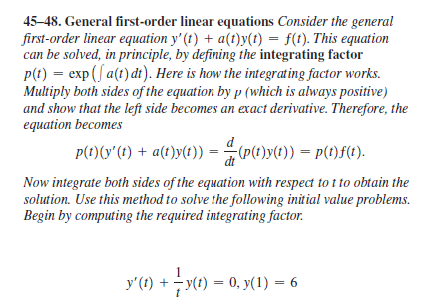45-48. General first-order linear equations Consider the general first-order linear equation y' (t) + a(t)y(t) = f(1). This equation can be solved, in principle, by defining the integrating factor P(t) = exp (f a(t) di). Here is how the integrating factor works. Multiply both sides of the equation by p (which is always positive) and show that the left side becomes an exact derivative. Therefore, the equation becomes p(t)(y'(t) + a(t)y(t)) = (p(t)y(t)) = P(t)f(1). Now integrate both sides of the equation with respect to t to obtain the solution. Use this method to solve the following initial value problems. Begin by computing the required integrating factor. y' () + - у() — 0, у(1) 3D 6 y(1) = 0, y(1) = 6
45-48. General first-order linear equations Consider the general first-order linear equation y' (t) + a(t)y(t) = f(1). This equation can be solved, in principle, by defining the integrating factor P(t) = exp (f a(t) di). Here is how the integrating factor works. Multiply both sides of the equation by p (which is always positive) and show that the left side becomes an exact derivative. Therefore, the equation becomes p(t)(y'(t) + a(t)y(t)) = (p(t)y(t)) = P(t)f(1). Now integrate both sides of the equation with respect to t to obtain the solution. Use this method to solve the following initial value problems. Begin by computing the required integrating factor. y' () + - у() — 0, у(1) 3D 6 y(1) = 0, y(1) = 6
Calculus: Early Transcendentals
8th Edition
ISBN:9781285741550
Author:James Stewart
Publisher:James Stewart
Chapter1: Functions And Models
Section: Chapter Questions
Problem 1RCC: (a) What is a function? What are its domain and range? (b) What is the graph of a function? (c) How...
Related questions
Question

Transcribed Image Text:45-48. General first-order linear equations Consider the general
first-order linear equation y' (t) + a(t)y(t) = f(1). This equation
can be solved, in principle, by defining the integrating factor
P(t) = exp (f a(t) di). Here is how the integrating factor works.
Multiply both sides of the equation by p (which is always positive)
and show that the left side becomes an exact derivative. Therefore, the
equation becomes
p(t)(y'(t) + a(t)y(t))
= (p(t)y(t)) = P(t)f(1).
Now integrate both sides of the equation with respect to t to obtain the
solution. Use this method to solve the following initial value problems.
Begin by computing the required integrating factor.
y' () + - у() — 0, у(1) 3D 6
y(1) = 0, y(1) = 6
Expert Solution
This question has been solved!
Explore an expertly crafted, step-by-step solution for a thorough understanding of key concepts.
Step by step
Solved in 4 steps

Recommended textbooks for you

Calculus: Early Transcendentals
Calculus
ISBN:
9781285741550
Author:
James Stewart
Publisher:
Cengage Learning

Thomas' Calculus (14th Edition)
Calculus
ISBN:
9780134438986
Author:
Joel R. Hass, Christopher E. Heil, Maurice D. Weir
Publisher:
PEARSON

Calculus: Early Transcendentals (3rd Edition)
Calculus
ISBN:
9780134763644
Author:
William L. Briggs, Lyle Cochran, Bernard Gillett, Eric Schulz
Publisher:
PEARSON

Calculus: Early Transcendentals
Calculus
ISBN:
9781285741550
Author:
James Stewart
Publisher:
Cengage Learning

Thomas' Calculus (14th Edition)
Calculus
ISBN:
9780134438986
Author:
Joel R. Hass, Christopher E. Heil, Maurice D. Weir
Publisher:
PEARSON

Calculus: Early Transcendentals (3rd Edition)
Calculus
ISBN:
9780134763644
Author:
William L. Briggs, Lyle Cochran, Bernard Gillett, Eric Schulz
Publisher:
PEARSON

Calculus: Early Transcendentals
Calculus
ISBN:
9781319050740
Author:
Jon Rogawski, Colin Adams, Robert Franzosa
Publisher:
W. H. Freeman


Calculus: Early Transcendental Functions
Calculus
ISBN:
9781337552516
Author:
Ron Larson, Bruce H. Edwards
Publisher:
Cengage Learning